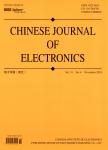Field-Line-Circuit Coupling Based Method for Predicting Radiated Electromagnetic Emission of IGBT-PMSM Drive System
Field-Line-Circuit Coupling Based Method for Predicting Radiated Electromagnetic Emission of IGBT-PMSM Drive System作者机构:College of Electrical and Information Engineering Hunan University School of Mechanical and Electrical Engineering University of Electronic Science and Technology of China
出 版 物:《Chinese Journal of Electronics》 (电子学报(英文))
年 卷 期:2021年第30卷第3期
页 面:561-569页
核心收录:
学科分类:080903[工学-微电子学与固体电子学] 080904[工学-电磁场与微波技术] 0809[工学-电子科学与技术(可授工学、理学学位)] 08[工学] 0807[工学-动力工程及工程热物理] 080501[工学-材料物理与化学] 0805[工学-材料科学与工程(可授工学、理学学位)] 080502[工学-材料学]
基 金:supported by the National Natural Science Foundation of China (No.51675086) the Fellowship of China Postdoctoral Science Foundation (No.2020M672482) the Open Foundation of the Science and Technology on Electronic Test&Measurement Laboratory (No.6142001180205)
主 题:field-line-circuit coupling electromagnetic calculation method power cable parameters permanent magnet motors electromagnetic interference electromagnetic field electromagnetic compatibility design Electric vehicle electromagnetic compatibility radiated EMI problems Permanent magnet synchronous motor predicting radiated Electromagnetic emission IGBT-PMSM drive system interconnection cables load PMSM effective field-linecircuit coupling power cables synchronous motors EMI source synchronous motor drives machine control Insulated gate bipolar transistor power device electric drives electromagnetic fields Electric drive system insulated gate bipolar transistors serious radiated Electromagnetic interference IGBT device
摘 要:Electric drive system with Insulated gate bipolar transistor(IGBT) power device is widely used in Electric vehicle(EV), which consists of inverter, cables and Permanent magnet synchronous motor(PMSM). Due to the fast switching in di/dt and dv/dt of IGBT device,the system produces serious radiated Electromagnetic interference(EMI) through the interconnection ***, modeling of EMI source, propagation path and load PMSM is the key to accurately evaluate the system s radiation level. In addition, the system s radiated EMI involves the integrated calculation of circuit, cable and electromagnetic field, which cannot be solved by using a single circuit or electromagnetic calculation method. Therefore, this paper develops an effective fieldlinecircuit coupling based method to investigate the radiated EMI problems for IGBT-PMSM drive system,which is validated by experimental measurement. Besides,the impact of power cable parameters on radiated EMI is discussed. The proposed approach has guiding significance for electromagnetic compatibility design of EV.



